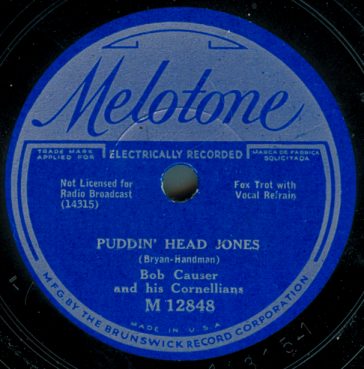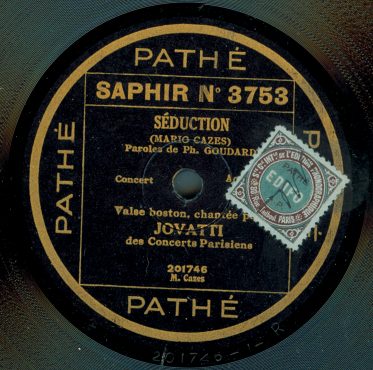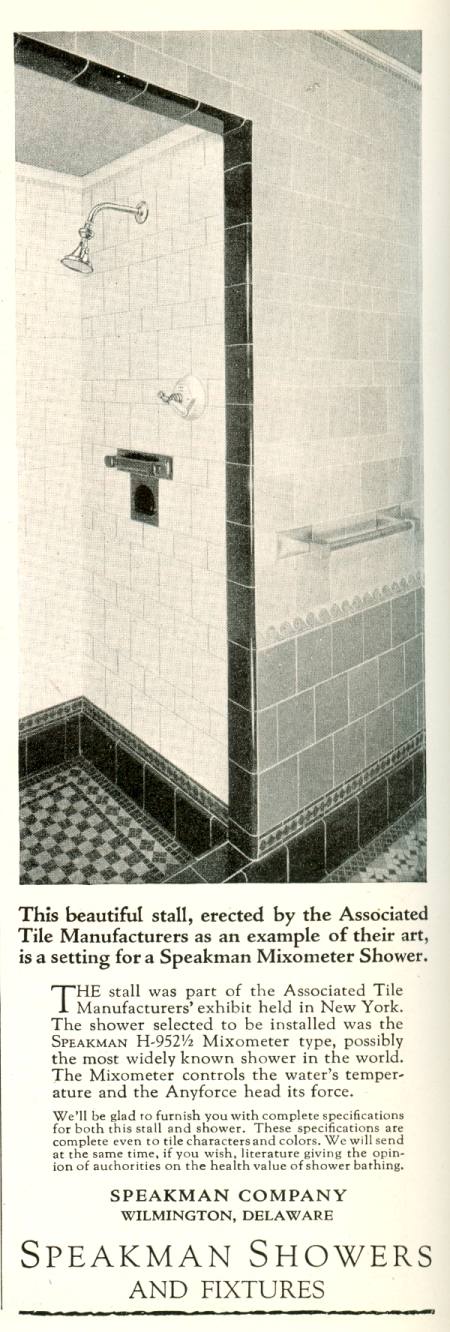

December 2007
December 20
This week's Hit of the Week is brought
to you by

Coca-Cola
Delicious and Refreshing
(from 1936 ad)

Puddin
Head Jones
Bob Causer And His Cornellians
Chick Bullock, vocal
1933
(Melotone M12848 mx 14315)
My
Old Man
Bob Causer And His Cornellians
Chick Bullock, vocal
1933
(Melotone M 12848 mx 14316)
Though he is largely forgotten today,
Chick Bullock, the vocalist on this week's selections was one of the most
recorded and recognizable voices of the 1930s. Most of his recordings
were made as the in-house vocalist for the American Record Corporation,
the parent company of a number of Depression era "dime store" labels.
While there was an actual band named
Bob Causer and His Cornellians, the band on both of these recordings was
the Don Redman Orchestra. According to the Big
Bands Database, Causer was a hotel manager in Ithica, New York
who formed a band for his hotel by recruiting musicians from nearby Cornell
University. A good number of recordings were issued under the
Bob Causer name on Melotone and various low-priced "dime store" subsidiary
labels of the American Record Corporation. Some of the Causer
recordings were made by in-house ARC studio bands while, in other instances,
recordings by the Will Osborne, Russ Morgan and Freddy Martin orchestras
were issued under the Bob Causer pseudonym.
The recording session with the Don
Redman Orchestra from which both of this week's selections came was held
in New York on November 14, 1933. The two other sides that came from
the session were issued under the name Earl Harlan and His Orchestra which
was a pseudonym that was used for other ARC recordings by Don Redman.
Today the willingness of artists
to record under someone else's name seems very odd. However, in the
1920s and 1930s, sales of recordings were heavily driven by song title.
Unlike recent decades where popular songs are often associated with or
are exclusive to specific artists, the big "tin pan alley" music
publishing firms were still the major promotional force behind popular
music. Whenever a new song with strong commercial potential was published,
every major record label would attempt to cash in by recording
one or more versions. Record buyers were just as likely to
seek out recordings based on songs they initially enjoyed in a show,
on the radio or in a talking picture as they were to look for recordings
by a favorite artist. If they could afford it, they might
buy a version of a song by a well-known artist they were familiar
with for 75 cents on a premium label such as Victor, Brunswick or Columbia.
But if they were on a budget, they would likely choose from what was available
from the 35 cent bargain records sold at places such as dime stores and
often branded with a label that was unique to that particular dime store
chain. After factoring in currency inflation, 75 cents
in 1933 was equal to about $11.87 in 2007 and 35 cents was worth about
$5.54. During the very worst period of the Depression when
many could not even afford the bargain records, this was a significant
price difference.
To keep costs low and to prevent
them from cannibalizing sales from their higher priced parent labels, the
bargain labels either used lesser-known bands or in-house studio bands.
Usually these studio bands were drawn from a pool of musicians and
even entire bands seeking to earn extra money on the side.
Sometimes a band's contract with a record label was only for the exclusive
use of its name thus permitting the band to record elsewhere under a different
name. The use of pseudonyms enabled the bargain labels to promote
what appeared to be a consistent and ongoing roster of exclusive
bands while enabling them to, behind the scenes, make use of whichever
musicians and bands were available to them at the moment.
The era of dime store labels and
pseudonyms came to a close with the establishment of Decca Records in the
USA in late 1934. Decca featured big name artists - mostly recruited
from Brunswick - for the same price as the various bargain labels.
Decca was an immediate success and helped revitalize the record industry.
In order to compete, other labels were forced to start offering name artists
on their bargain offerings. The success of Decca and RCA's
low-priced Bluebird label which were nationally distributed also made the
in-house labels offered by retail chains less attractive to customers.
- Dismuke
EXTRA
This section will present
78 rpm recordings that do not fall within the range of the vintage pop
and jazz fare that I usually present. Here I will feature
recordings from a wide variety of eras, musical genres and nationalities
as well as occasional spoken word recordings.

Seduction
Jovatti
1929
(Pathe Saphir N 3753 mx 201746)
Serment
Dí Amour
Jovatti
1929
(Pathe Saphir N 3753 mx 201926)
Here is a French record I recently
acquired. I have not been able to locate any information about the
vocalist, Jovatti. I did, however, immediately fall for the recording
of "Seduction" when I put it on the turntable despite the fact that I do
not understand French.
These recordings come from an old
vertical grooved Pathe disc. Pathe dates back to 1894 and pioneered
the French record industry. In the early decades of disc records,
the patents for the lateral "zig zag" grooves found on most conventional
78 rpm records were controlled by Victor and Columbia and their various
foreign affiliates. For this reason, when companies such as Edison,
Pathe and others began manufacturing disc records, they used the
vertical or "hill and dale" grooves that had previously been used on cylinder
records.
The very early Pathe disc records
were unusual in just about every respect. The had a playback
speed of 90 rpm and were issued in non-standard sizes - some as large
as 20 inches in diameter. Furthermore, the records' grooves started in
the center and played outward to the edge of the record. Pathe
records could only be played on a Pathe machine which featured a special
stylus tipped with a rolling sapphire ball. It was claimed that the
sapphire ball eliminated wear on both the record and the stylus.
While Edison's Diamond Disc records were also vertically cut, their playback
required a special diamond stylus. Thus Edison's and Pathe's records
were just as incompatible on each other's machines as were the conventional
lateral cut records which used steel needles.
Pathe was extremely successful in
the French market. It was less successful when it began production
in the US market in 1916. By this time, Pathe records were no longer
center-start and the playback speed had been reduced to 80 rpm. But
they still required the special sapphire ball playback equipment which
undoubtedly made sales more difficult. In late 1920, after
the Victor and Columbia patents expired, Pathe's US and UK branches
introduced a line of lateral cut records which they named Pathe Actuelle
- and these records, along with their US bargain label, Perfect,
were commercially successful. In 1925, Pathe discontinued
production of vertical cut records in the US. However, in France,
where many people had Pathe machines, its vertical cut records were still
in demand.
Pathe records were also unique in
that its studio sessions were recorded on oversized wax cylinders at a
very high rpm. This enabled Pathe to dub the same recording pantographically
to both vertical and lateral masters. Unfortunately, one can
sometimes hear on early 1920s Pathe and Perfect records extraneous noise
produced during this dubbing process.
I don't have any information when
production of lateral-cut Pathes began in France. It wasn't until
1927 that the company converted from acoustical to electrical recording.
In France, the sapphire-ball discs remained in production until 1932
making French Pathe the last company to commercially produce vertical grooved
records.
Pathe also had branches in
several other countries. While they were but a minor player in the
USA and UK markets, they had a strong presence in Czarist Russia
with factories and/or studios in cities such as Moscow, St. Petersburg,
Kiev, Odessa, Rostov and Warsaw. I have read that a large percentage
of pre Russian Revolution era recordings of Ukrainian folk music were issued
by Pathe and that Pathe's gramophone trademark continued to
exist in popular slang usage as a generic term for wind-up record players
in the USSR long after the Soviets had confiscated Pathe's factories and
abolished all trademarks.
I should mention that Pathe was
also a pioneer in the motion picture industry producing equipment
and operating studios and cinemas. The company still produces
films and operates cinemas in Europe. Pathe's record business
was sold off in 1928. Its American operations were purchased
by Cameo Records which soon afterwards became part of the American Record
Corporation. Its European operations were sold to English Columbia
which became part of EMI in 1931. My understanding is that EMI still
issues recordings under the Pathe name.
- Dismuke
December 13
This week's Hit of the Week is brought
to you by

Matson Line - Oceanic Line
(from 1932 ad)
Note - I am very please to welcome
back guest contributor Matt From College Station as he shares some
more recordings from his excellent collection of 1920s and 1930s jazz and
dance band 78 rpm records.
All recordings and commentary
in this update, both the regular and the "Extra" sections, are from Matt.
My only contribution was to transfer and digitalize the recordings.
You can learn more about Matt
and find his contact information by clicking here.
Charleston
Baby Of Mine
Don Bestor And His Orchestra
1925
(Victor 19751-B)
Summer
Nights
Don Bestor And His Orchestra
1925
(Victor 19751-A)
Don Bestor began playing piano at
age 16 and led and played with dance bands throughout the early 1920s.
In the mid 1920s Bestor took over
the Benson Orchestra of Chicago and transformed it into his own jazzy band.
He was popular during this time and continued to make records with Victor,
as he had with the Benson Orchestra.
In the early 1930s Bestor was popular
on radio and, for a while, was appeared on both the Walter O'Keefe and
the Jack Benny programs. After a brief recording hiatus he began
recording with Victor again in 1932, but this time in the sweet band format.
He remained with Victor until late 1934 when he began recording with Brunswick.
Bestor folded the band in 1943,
as did many other bandleaders during World War II. His only number one
hit was "Forty Second Street," from March 1933.
The first tune presented here
is a snappy 1925 arrangement of "Charleston Baby Of Mine." As the name
suggests it is a Charleston Fox Trot and captures the jazzy and carefree
feel of the '20s. Out of all the early electric recordings that the Victor
Talking Machine Company released in 1925-1926, this is in my top 10.
"Summer Nights," the next tune, is a tango style Fox Trot. Although not
as jazzy it definitely pleases the ear.
- Matt From College Station
EXTRA
This section will present
78 rpm recordings that do not fall within the range of the vintage pop
and jazz fare that I usually present. Here I will feature
recordings from a wide variety of eras, musical genres and nationalities
as well as occasional spoken word recordings.
Moon
For Sale
Les Allen And His Canadian Bachelors
1935
(UK Columbia FB 1278 mx CA 15518)
Mine
Alone
Les Allen And His Canadian Bachelors
1935
(UK Columbia FB 1278 mx CA 15519)
British musician Les Allen bounced
back between Great Britain and Canada throughout his life, playing with
bands in both countries.
His big break came in 1932 when
he signed with the Henry Hall BBC Dance Orchestra and became a featured
vocalist. He also worked with the bands of Carroll Gibbons, George
Melachrino, and Geraldo at that time.
In 1934 his solo career started
with a recording for Britain's Columbia label, and he soon formed
a singing group called The Canadian Bachelors with Jack Curtis, Herbie
King and Cy Mack. Les Allen also starred in the 1937 film Heat Wave.
By 1948 when he retired to Toronto he had made hundreds of recordings.
He died in 1996 at the ripe old age of 94.
The two selections presented here
are great recordings. I am especially impressed with the close harmony
work on "Moon For Sale" as well as the beautiful melody.
- Matt From College Station

|


